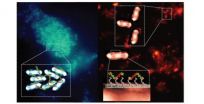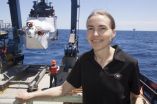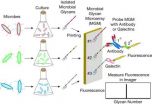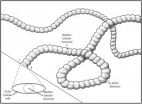(Press-News.org) The breakthrough, published in the journal Nature Materials, could offer an easier way of detecting pathogenic bacteria outside of a clinical setting and could be particularly important for the developing world, where access to more sophisticated laboratory techniques is often limited.
The research was led by Professor Cameron Alexander, Head of the Division of Drug Delivery and Tissue Engineering and EPSRC Leadership Fellow in the University's School of Pharmacy, building on work by PhD student Peter Magennis. Professor Alexander said: "Essentially, we have hijacked some of the metabolic machinery which bacteria use to control their environment, and used it instead to grow polymers which bind strongly to the specific bacteria that produce them.
"The neat thing about this is that the functionality of the polymers grown on the surface of the bacteria is programmed by the cells so that they can recognise their own 'kind'. We used fluorescent labels to light up the polymers and were able to capture this labelling using a mobile phone camera, so in principle it could be possible to use these materials as point-of-care diagnostics for pathogenic bacteria."
The study has shown that the bacteria helped to synthesise polymers on their own surfaces which not only were different from those made by conventional methods, but which retained a form of 'structural memory' of that surface. This means in future it should be possible to make specific detection agents or additives for topical anti-infectives that target a number of harmful bacteria all by a common route.
"The initial focus of the research was to explore ways to use synthetic polymers to selectively target and bind the bacteria that cause dental cavities and periodontal diseases in order to facilitate their removal from the oral cavity," said Dr David Churchley, Principal Scientist, Oral Health Category Research and Development, GSK Consumer Healthcare. "As we continued our work, we saw that our research had broader implications and potential for a wider range of uses."
Rapidly identifying harmful bacteria at the heart of a serious medical or dental condition can be a difficult and costly task. The group's findings may even lead to new ways of treating bacterial infections. "These types of polymers may be designed to contain antibacterial functionalities so that they specifically bind to and kill bacterial pathogens," said Dr Klaus Winzer, a microbiologist at The University of Nottingham involved in the study. The selective binding of specific bacterial species and/or strains in current practice requires expensive 'cold-chain' reagents such as antibodies which often preclude using these processes outside of a hospital setting or in developing nations.
The new approach, termed 'bacterial-instructed synthesis', has the potential for use in the developing world, in the field or in less specialised laboratory settings.
Dr David Bradshaw, Principal Scientist, Oral Health Category Research and Development, GSK Consumer Healthcare, said: "The ingredients used to form the polymers are all easy to obtain, inexpensive and widely available. With the simplicity and accessibility of the chemistry, a number of diagnostic and other applications may be possible."
INFORMATION:
The study was funded by a Biotechnology and Biological Sciences Research Council (BBSRC) GSK Consumer Healthcare CASE studentship, and Professor Alexander's Engineering and Physical Research Council (EPSRC) Leadership Fellowship.
The paper will be accessible on the Nature Materials website (after the embargo has lifted) at http://dx.doi.org/10.1038/nmat3949
Hijacking bacteria's natural defences to trap and reveal pathogens
2014-05-11
ELSE PRESS RELEASES FROM THIS DATE:
UGA research examines fate of methane following the Deepwater Horizon spill
2014-05-11
Athens, Ga. – The 2010 Deepwater Horizon blowout discharged roughly five million gallons of oil and up to 500,000 tons of natural gas into Gulf of Mexico offshore waters over a period of 84 days. In the face of a seemingly insurmountable cleanup effort, many were relieved by reports following the disaster that naturally-occurring microbes had consumed much of the gas and oil.
Now, a team of researchers led by University of Georgia marine scientists have published a paper in the journal Nature Geoscience that questions this conclusion and provides evidence that microbes ...
Galectins direct immunity against bacteria that employ camouflage
2014-05-11
Our bodies produce a family of proteins that recognize and kill bacteria whose carbohydrate coatings resemble those of our own cells too closely, scientists have discovered.
Called galectins, these proteins recognize carbohydrates from a broad range of disease-causing bacteria, and could potentially be deployed as antibiotics to treat certain infections. The results are scheduled for publication in Nature Chemical Biology.
Researchers at Emory University School of Medicine made the discovery with the aid of glass slides coated with an array of over 300 different glycans ...
Study finds patients AFib at higher risk of dementia when meds out of range
2014-05-10
A new study by researchers at the Intermountain Medical Center Heart Institute in Salt Lake City has found that atrial fibrillation patients who are on blood thinning medications are at higher risk of developing dementia if their doses are not in the optimal recommended range.
The study of more than 2,600 AFib patients found they are significantly more likely to develop dementia when using medicines to prevent blood clots, such as warfarin, when their dosing is too high or too low for an extended period of time.
Findings from the study will be presented at the 2014 ...
Bee biodiversity boosts crop yields
2014-05-10
Research from North Carolina State University shows that blueberries produce more seeds and larger berries if they are visited by more diverse bee species, allowing farmers to harvest significantly more pounds of fruit per acre.
"We wanted to understand the functional role of diversity," says Dr. Hannah Burrack, an associate professor of entomology at NC State and co-author of a paper on the research. "And we found that there is a quantifiable benefit of having a lot of different types of bees pollinating a crop."
The researchers looked at blueberries in North Carolina ...
Scientists find gene behind a highly prevalent facial anomaly
2014-05-10
CAMBRIDGE, Mass. (May 9, 2014) – Whitehead Institute scientists have identified a genetic cause of a facial disorder known as hemifacial microsomia (HFM). The researchers find that duplication of the gene OTX2 induces HFM, the second-most common facial anomaly after cleft lip and palate.
HFM affects approximately one in 3,500 births. While some cases appear to run in families, no gene had been found to be causative. That is until Whitehead Fellow Yaniv Erlich and his lab set out to do just that. Their work is described in this week's issue of the journal PLOS ONE.
Patients ...
Cardiac screening test may help determine who should take aspirin to prevent heart attack
2014-05-09
MINNEAPOLIS, MN – May 6, 2014 – For over 30 years, aspirin has been known to prevent heart attacks and strokes, but who exactly should take a daily aspirin remains unclear. New research published today in Circulation: Cardiovascular Quality and Outcomes shows that your coronary artery calcium (CAC) score, a measurement of plaque in the arteries that feed the heart, may help determine whether or not you are a good candidate for aspirin.
"Many heart attacks and strokes occur in individuals who do not appear to be at high risk," states lead author, Michael D Miedema, MD, ...
NASA's TRMM Satellite see spring storms hit the US Great Plains
2014-05-09
VIDEO:
The TRMM satellite flew above tornado spawning thunderstorms in the southern United States on May 9, 2014 at 0115 UTC. This simulated 3-D TRMM animation shows the location of intense...
Click here for more information.
The Tropical Rainfall Measuring Mission or TRMM satellite captured rainfall and cloud height information about the powerful thunderstorms and severe weather that affected the Great Plains over May 8 and 9.
Severe weather extended from Minnesota to southern ...
Plugging leaky blood vessels to save vision
2014-05-09
TORONTO – A new drug approach has been developed for safer clean-up of deformed blood vessels in the eye by a research team at the Lunenfeld-Tanenbaum Research Institute, Mount Sinai Hospital in Toronto.
The growth of malformed blood vessels that can burst is a leading cause of vision loss in North America. Retinopathy and retina degeneration are associated with premature birth, with diabetes, and with increasing age.
Research just published by Dr. Andras Nagy and co-authors shows both safety and effectiveness in their bioengineered compound when treating retinopathy ...
Paleontologists discover new fossil organism
2014-05-09
RIVERSIDE, Calif. — Scientists at the University of California, Riverside have discovered a fossil of a newly discovered organism from the "Ediacara Biota" — a group of organisms that occurred in the Ediacaran period of geologic time.
Named Plexus ricei and resembling a curving tube, the organism resided on the Ediacaran seafloor. Plexus ricei individuals ranged in size from 5 to 80 centimeters long and 5 to 20 millimeters wide. Along with the rest of the Ediacara Biota, it evolved around 575 million years ago and disappeared from the fossil record around 540 million ...
Discovery links rare, childhood neurodegenerative diseases to common problem in DNA repair
2014-05-09
(MEMPHIS, Tenn. – May 9, 2014) St. Jude Children's Research Hospital scientists studying two rare, inherited childhood neurodegenerative disorders have identified a new, possibly common source of DNA damage that may play a role in other neurodegenerative diseases, cancer and aging. The findings appear in the current issue of the scientific journal Nature Neuroscience.
Researchers showed for the first time that an enzyme required for normal DNA functioning causes DNA damage in the developing brain. DNA is the molecule found in nearly every cell that carries the instructions ...





